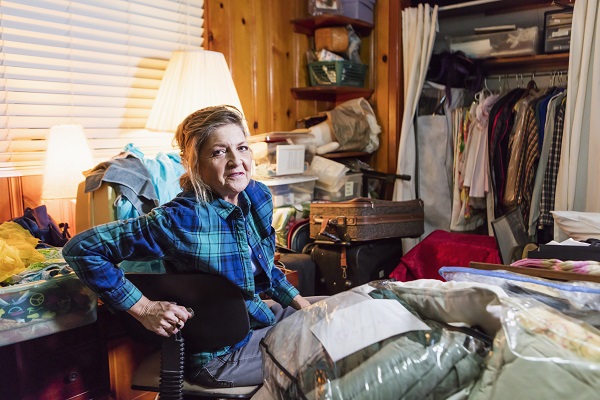Caring for Someone Who Hoards
 Lots of us have collections. Maybe you bring home a new refrigerator magnet from every vacation destination you visit. Perhaps you love jewelry and have a statement necklace for every occasion. Maybe rare baseball cards are carefully stored and organized in a box in your basement. But compulsive hoarding is different from an out-of-control collection or two.
Lots of us have collections. Maybe you bring home a new refrigerator magnet from every vacation destination you visit. Perhaps you love jewelry and have a statement necklace for every occasion. Maybe rare baseball cards are carefully stored and organized in a box in your basement. But compulsive hoarding is different from an out-of-control collection or two.
What is Hoarding?
The International Obsessive-Compulsive Disorder Foundation reports that signs of hoarding include:
- Accumulating more and more items at home, even when there is no space
- Saving junk mail, package materials and obsolete, useless items
- Compulsive shopping, sometimes purchasing several of the same item
- Leaving items unopened in their original packaging
- Experiencing difficulty choosing which items to keep and which to discard
- Having trouble reaching or locating items a person really needs
The house or apartment may be so filled with objects that it becomes unsanitary or dangerous. The person may be unable to safely reach their kitchen to prepare nutritious food, or their bathroom to bathe and use the restroom. This chaotic clutter creates risks for falls and other injuries, and exacerbates self-neglect and isolation. The person may be too ashamed of their surroundings to receive necessary care or let in maintenance professionals. This can lead to further social isolation and a cycle where the person perceives possessions as the source of comfort and security. Extreme hoarding may even lead to eviction and homelessness.
Approximately 3% to 5% of the U.S. population suffers from compulsive hoarding—statistically small, but that’s about 19 million people. And not only the hoarder suffers. Family members and people who care for them are negatively affected as well.
Emerging research shows that the stress and anxiety brought on by the COVID-19 pandemic exacerbated hoarding behaviors and increased the risk of hoarding in those who were already vulnerable to it. Worry and perception of threat were the most frequent reasons cited by studies that looked at troublesome stockpiling. But there is no single cause of hoarding.
“Hoarding can also occur in people with dementia, schizophrenia, and obsessive-compulsive disorder [OCD],” says Gail Steketee, LCSW, MSW, PhD, a professor and dean at Boston University, “but it is not clear that the features and causes are the same.”
How to Get Help
Television reality shows with professional organizers or “intervention” shows make it seem like all hoarders need is one good cleanup to rid themselves of their excess possessions. But the reality is that hoarding almost always requires intense intervention.
“Hoarding, in many ways, has elements of addictions like gambling and so forth, where the excitement drives the behavior. It’s like a high that people get very stuck on, and it’s hard to get over,” Steketee said.
Families may be tempted to start cleaning out the clutter themselves, perhaps while the person living there is away. But people who study hoarding say that’s not the right approach. Steketee says to approach your loved one with a tone of concern about their safety. Paper stored near a stove, for example, could quickly cause a fire.
Still, family may have trouble tackling the problem on their own. Thankfully there are resources available for people who hoard and for the people who love or take care of them. Family can reach out to:
Social service agencies. Many cities, counties and states now have multi-agency “hoarding task forces,” through the local health department, adult protective services agency, or housing department. In some cases, an agency will step in and order a forcible cleanup, but this is generally not the best solution. The results are often only temporary, and the emotional distress may cause the person to resume collecting with increased vigor.
Mental health professionals. For most people experiencing this problem, progress is difficult without the assistance of a therapist or counselor to help them understand the underlying causes. The goal is for the person who hoards to become self-motivated, understanding that the clutter of possessions is a barrier against leading a more satisfying life.
Aging life care professionals (also known as geriatric care managers). These professionals can help seniors and families develop a plan for dealing with an unsafe living environment and for downsizing when a senior needs to move. They help seniors make decisions about their belongings, and can coordinate services, such as a mental health professional and a cleaning service. Perhaps most importantly, they help seniors and families negotiate the emotional pitfalls as families try to step in to help their loved one clean up.
Organization coaches and specialized cleaning services. These professionals specialize in home clutter, and will come to the home to help a person develop a strategy for sorting, organizing and discarding possessions. Some cleaning services also specialize in hazardous and extremely cluttered home conditions.
Support groups. In-person and online groups, some facilitated by professionals, provide a safe place where compulsive hoarders receive encouragement, advice and understanding as they work to bring organization and control to their own lives. Support groups are also available for family members.
With assistance, people who hoard can gain the upper hand over their condition and, in the process, get a greater sense of control over their lives.
Source: IlluminAge AgeWise
![Resilience Home Health [logo]](https://www.resiliencehomehealth.com/wp-content/uploads/sites/345/2023/06/logo-2023.png)